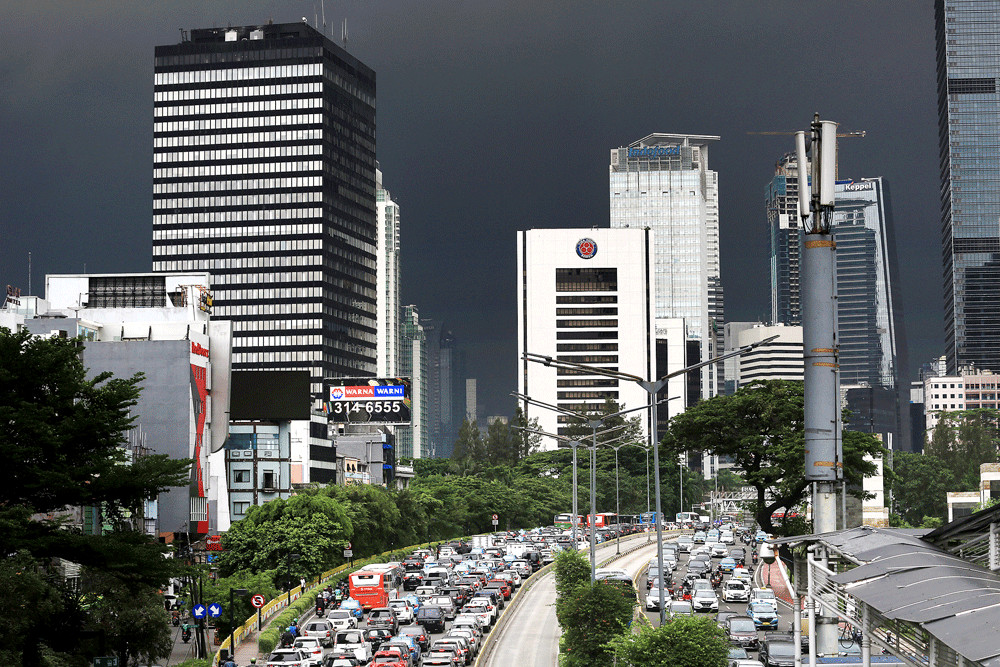Expect unexpected weather: BMKG
Change Size
 Heavy clouds are seen in the sky above Jakarta on Tuesday. The Meteorology, Climatology and Geophysics Agency (BMKG) is monitoring and analyzing rainfall across Indonesia. It said in its latest report that rain had hit various parts of Java over the last several weeks, causing flooding and landslides. (The Jakarta Post/Dhoni Setiawan)
Heavy clouds are seen in the sky above Jakarta on Tuesday. The Meteorology, Climatology and Geophysics Agency (BMKG) is monitoring and analyzing rainfall across Indonesia. It said in its latest report that rain had hit various parts of Java over the last several weeks, causing flooding and landslides. (The Jakarta Post/Dhoni Setiawan)
In the past two weeks, Greater Jakarta has been hit by unusual weather phenomena.
On Wednesday, hail was reported in Depok, West Java, following heavy rain that poured onto the city. A video taken on Jl. Serua in Bojong Sari showed piles of ice pellets on the ground.
The Meteorology, Climatology and Geophysics Agency (BMKG), however, said that hail is not an extraordinary occurrence in a tropical country. Hail usually only lasts about 10 minutes and is followed by regular rain.
BMKG spokesman Harry Tirto said there were some signs to indicate hail was about to fall. First, temperatures increase in the night time and morning before hail appears; it is usually 4.5 degrees Celsius hotter than usual. That condition is followed by the formation of white clouds that subsequently turn dark grey. Such clouds are called cumulonimbus.
“What’s happening [in Greater Jakarta] is heavy rain with lightning, thunder and short periods of strong wind. It’s not a thunderstorm,” he added.
The agency predicts cities within Greater Jakarta to continue experiencing such weather in the upcoming weeks.
Moreover, through its official website www.bmkg.go.id, the agency says it has been monitoring a weather phenomenon called the Madden-Julian Oscillation (MJO), which usually manifests in anomalous rainfall that occurs not only in Jakarta, but also across the archipelago.
The MJO, which brings extra water vapor to form clouds in the sky, potentially increases the occurrence of heavy rain and strong wind, followed by thunder.
Heavy downpours and strong winds in the past few weeks have resulted in a considerable amount of damage and have even resulted in injuries and deaths.
In South Jakarta, earlier this week on Dec. 10, strong wind that hit the capital severely destroyed the roof of the Rasuna Garden Food Street in Kuningan. A video went viral showing metal sheets from the top of the building flying away. Visitors ran away in panic.
Hundreds of trees across the city have also been toppled by the extreme weather. The latest incident took place on Tuesday in Kembangan, West Jakarta.
The local Disaster Mitigation Agency (BPBD) worked hard to clear up toppled trees on Jl. Intan Meruya Ilir, Jl. Taman Aries, Jl. Kembangan Utara Raya, Jl. Baru Presisi, Jl. Penyelesaian Tomang, Jl. Kembang Kerep and the Puri Indah Mall.
Last week, a tornado that struck Bogor, West Java, killed one person and destroyed 848 houses and five vehicles. It toppled dozens of trees, which fell upon three private cars and two public minivans, in three villages.
The fatality, who was identified as Enny Reno, a 46-year-old resident of the Bogor Nirwana Residence housing complex, was killed when a tree fell onto her car while she was driving.
The local police had built temporary shelters and public kitchens for those whose homes were damaged by the weather, while the Bogor disaster mitigation team and emergency response unit, Tagana, continues to assess the damage and relocate residents.
Meanwhile, the Jakarta administration has repeatedly identified dozens of places across the city that are prone to flooding. Floods and landslides have started happening. Some residents even worry that this rainy season would bring the kind of severe flooding that usually only occurs once in five or six years.
Although Harry maintained that there is no such thing as a flood cycle, Jakarta residents have come to believe a five-year cycle exists after experiencing severe floods in 1996, 2002, 2007 and 2013. In 2013, floodwaters reached the center of the capital, inundating the Hotel Indonesia traffic circle.
***
This article was originally published in The Jakarta Post's print edition on Dec. 14, 2018, with the title "Expect unexpected weather: BMKG".










